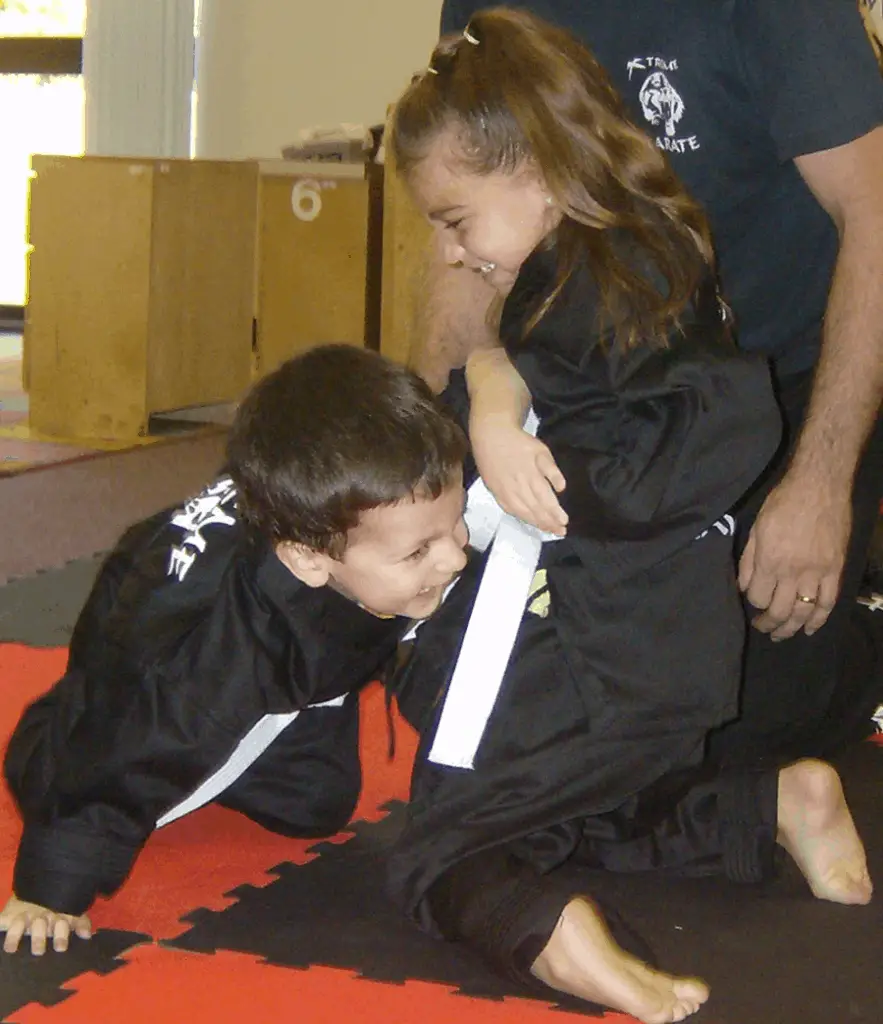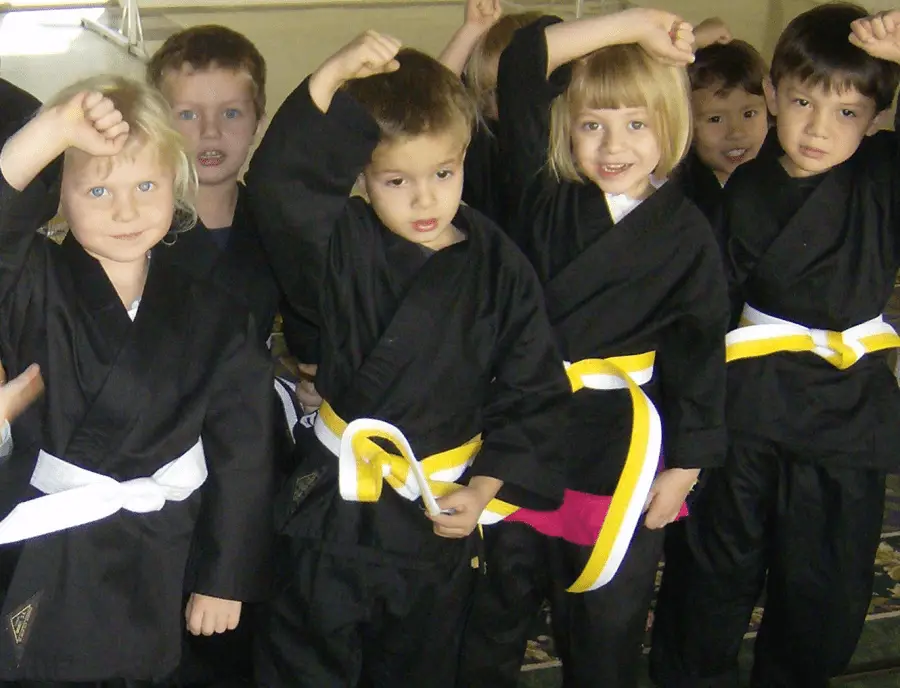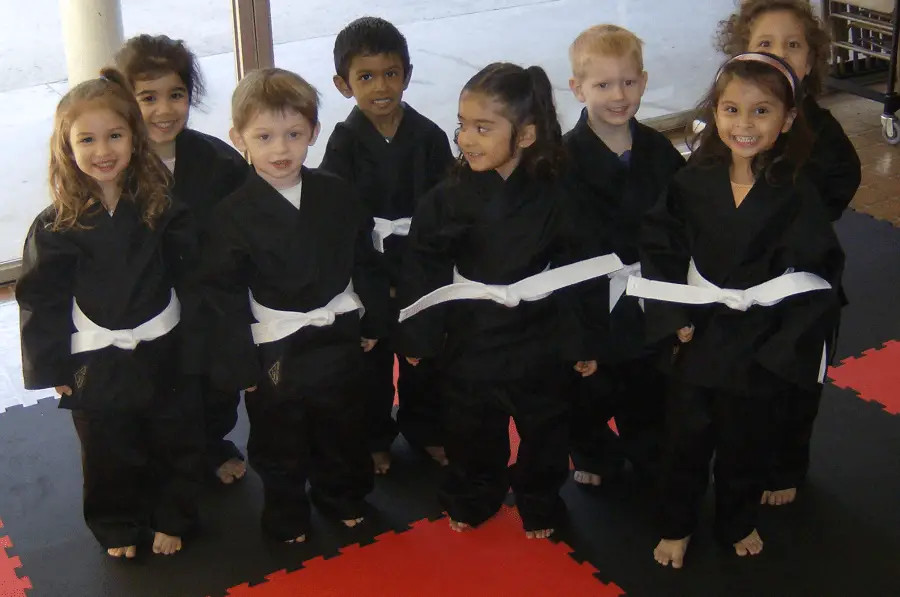
Everyone wants to provide their preschool aged children with the best developmental environment possible. Martial Arts training rises to the top for preschoolers when many different factors are considered.
Data from medical and educational studies show that martial arts training improves mental, physical, and emotional health in preschool aged children more than other sport related activities. Added to these are the virtue and self defense characteristics found in nearly every variation of the arts.
What are some of these benefits and how is it that martial arts training can give them to preschool aged children more effectively than other forms of sport exercise? A look at university research on the subject shines a positive light on the traditional practices found in Karate, TaekwonDo, Judo and other classes.
Contents
- Studies on the Benefits of Grappling Systems in Preschool Children
- Studies On the Benefits of Striking Based Systems
- A Study Shows Behavioral Benefits For Preschoolers In Martial Arts Classes
- Confidence, Respect, and Kindness Through the Martial Arts For Little Minds
- Self Discipline Is A Huge Benefit to Start at Such a Young Age
- Self Defense Is Actually a Big Issue in Preschool Aged Group Play
- The Takeaway…
Studies on the Benefits of Grappling Systems in Preschool Children
In a study published in Pediatric Exercise Science, the official journal of the North American Society For Pediatric Exercise Medicine, after 9 months of training in both recreational sports and Judo martial arts training, young boys improved more of their fitness capabilities with Judo. They enjoyed greater gains and longer lasting effects in speed, core strength, and flexibility.
This comes as no surprise to martial artists and instructors who have known the benefits of wrestling and grappling systems since the first Olympic Games in Ancient Greece. One of the premiere sports featured in the early games and through the centuries has been wrestling in many forms.
For those looking to ensure their tiny tot stays in shape, an average one hour session of most styles of martial arts if done correctly burns more calories than running, cycling, or group sports. It nearly doubles the calorie burn of stretching activities like yoga or obstacle course style programs.
We all want the best for these Little Ninjas as they grow and develop. Having them move for the sake of movement will bring a chorus of “I’m Bored”. Put things in that exercise that they like to watch in movies and cartoons (i.e. heroes saving the day through martial arts techniques) and you have a recipe for sustained high level engagement.
Not to mention, most dads know this. The number one bonding and play time activity between kids and their dads is… you guessed it. Wrestling. Spontaneous wrestling matches broke out in my house at least every other day, filled with sound effects and calls from my wife to keep it down. Fun, just plain fun.
A Story From Experience Teaching Grappling to Young Kids
I have taught literally thousands of children at this age over the last 25 years. One of the systems that seems to work really well for them is Judo (the same successes can also be had in other grappling arts such as Brazilian Jiu jitsu). Judo doesn’t utilize strikes of any kind. It is called “The Gentle Way” for that reason.

For adults practicing the art, that may seem to be a misleading title. Though for children this can definitely be the case. Even with the energy output required in a grappling or wrestling art, without strikes smaller children can feel safe to explore the limits of what their bodies can do in a safe manner.
I had a little boy who seemed to many to be over confident and a bit of a bully, imposing his will on others openly at times. His parents and teachers noted the same behavior at school and at home. Judo training immediately shined a light on his problem and made it clear what his actual problem was. He had extremely low self esteem and considered others to always be better than him.
This came out when practicing hold downs (called either pins or positions in some systems). A slightly bigger girl was paired up with him and try as he might, he couldn’t break her hold on him as she smiled and looked around. This sent the little boy into hysterics. He cried and threw a tantrum laying on the mat after the girl moved on to her next partner.
After talking with him for a few minutes he admitted that he didn’t want people to know he wasn’t as strong as others. His problem wasn’t that he thought he was stronger and better than everyone, causing him to treat them as inferior. He was aggressive with others in an attempt to stop them from finding out what he thought was his secret. He believed he didn’t measure up.
Grappling arts can be a good litmus test for young students. Failure is part of the experience. If you haven’t failed while training in a grappling system, it is probably because you haven’t attended your first class.
This little guy, like so many others learned how failure can shine a light on a person’s weakness and help you get to the business of correcting it. He did become more well adjusted over the couple of years I was his instructor, and Judo had a very positive impact.
Studies On the Benefits of Striking Based Systems
In another study done on preschool aged girls in comparison with other common exercise programs, data shows that the training in Karate outperforms the others significantly. The study was interested in cardiovascular health and breathing capacity before and after the study with a control group of children performing the standard variations of exercise.
In the study that can be found here, researchers found “that karate-related exercises have a better influence on the development of the respiratory system than standard interventions”. They also concluded that Karate training “is more beneficial for both the mental and physical development of preschool girls.”
So if this is true, why is it that so many schools and preschools don’t have these programs as regular parts of their curriculum. The simple answer is that the martial arts of any kind takes many years to develop the proficiency to be able to perform, much less teach.
Then there is the problem of teaching ability. Knowing how, is not the same as the ability to teach, and that problem is multiplied exponentially when dealing with young children. There is an art in and of itself to teaching preschool aged kids. Someone may be born with skills sets that can make a good teacher, but there is no substitute for years of training and experience. This is just hard to find.
If a school can find a capable and caring instructor to teach their kids who understands that these Little Ninjas are someone else’s little treasures, it can truly be an asset and a tool in shaping their futures. Karate, Judo, TaeKwonDo and many others that have good small kid elements to them can lead to a lifetime of goal shattering and success.
A Story From Experience Teaching Striking to Young Kids
I can’t number the times that a little boy or girl stood in front of me with tears about to stream down their cheeks, looking at a board in front of them they just ‘knew’ they weren’t going to be able to break. They had done the practice, attended the classes, and had increased their cardiovascular and muscle tone to match whatever I required of them to do.

But this was real now. In their minds, this board was either unbreakable or would send the dreaded SPLINTER into their foot, maiming them for life. These boards are in a thickness designed to be just challenging enough for their age and size, but to them Paul Bunyan couldn’t even put a crack in it.
After coaxing and reassurances I was able to convince them to at least give light taps, testing whether I was telling the truth or not about how safe it was. Eventually parents would cheer, other students would shout their name, they would hit harder and harder until… snap.
Now, you think you have seen joy and relief before, but nothing compares to the faces that I get a front row seat to witness. I can’t help, but laugh over half of the time. Eyes are huge, they look for mom or dad as if to say, “Did you see that?” It is classic.
Not only does a striking style push these young learners physically like the previous study shows, it also stretches them mentally. It challenges their preconceived notions about themselves and teaches them to explore reality for what it really is. The cheers are for them and they have broken more than their first board. They have broken through a barrier within themselves.
A Study Shows Behavioral Benefits For Preschoolers In Martial Arts Classes
In a study done by the Journal of Combat Sports and Martial Arts, researchers found that martial arts programs included in a preschooler’s daily program had a strong positive effect in the behavior of preschool children. These positive behavioral traits were in line with what would be expected of them by parents and teachers as they entered higher grades.
Further in the study, the data showed that martial arts training increased problem solving abilities in preschoolers. One reason for this is the fact that though the martial arts have set techniques and methods, when applying them to any given situation it becomes necessary to decide in the heat of the moment how best to utilize them.
The behaviors of the preschoolers in the study also spilled over into healthy practices in their home life. They initiated conversations about training and started exercising at home for their free time activities. These sorts of habits started early in life are much more likely to become a part of an adult’s lifestyle.
In children at the preschool age it is not uncommon for several in a group to take on aggressive roles one day, only to be helpful and empathetic another. This same study found that training in the martial arts gave them a greater concern for the welfare of others. They were recorded helping others solve their problems and parents reported increased socio-moral sensitivity and willingness to help others.
Confidence, Respect, and Kindness Through the Martial Arts For Little Minds
Most of what our Little Ninjas learn from us comes from mimicking what they see. We all inherently know that the absurd statement “do as I say and not as I do” is merely a parody. Of course there are things adults do that preschool aged children cannot. But it is the character shown in doing or not doing the right things that they will see and mimic.

Martial arts training is based on virtue and respect. They could not be practiced without them. If you hurt your training partner to make yourself feel superior, you will no longer have training partners. Without training partners there is no more advancement in techniques. This seems simple, but not so evident to little minds.
Experience seeing instructors and older more experienced students interact in respectful ways in situations where it could go much different is amazingly helpful to the preschooler. Telling them has a low percentage of success, but showing them… that can make all the difference.
All martial arts, even the most violent of military technical systems have one central element in mind. We do what we do for the protection of the other. Self defense is actually not as important if you have a good pair of running shoes. The central tenant of the martial arts is pushing back against injustice and choosing the appropriate time and manner to stand against it.
Martial arts teaches young ones that their actions directly and indirectly affect those around them. In order for them to reap the benefits of friendships and other social contacts, they learn to mitigate their own wills and respect those of others.
Self Discipline Is A Huge Benefit to Start at Such a Young Age
To gain nearly anything through martial arts training, one of the first core values that children have to learn is self discipline. Everything from classroom etiquette to show respect and ensure a safe environment to good practice habits play an important factor.
For those strong willed children, a competent instructor can redirect those energies into roles such as protector and champion of others rather than the rebel. Discipline in Karate, Judo, TaeKwonDo etc. is highly effective in inspiring kids to take control of their impulses. Impulse control is a major issue for many children at such a young develomental stage.
Empathy for the plight of others becomes a real and achievable goal for children even of this level through the ‘show not tell’ strategies inherent in the martial arts. Self control and taking the needs and wants of others into account through partner practice develops the understanding of the importance of community.
We are social animals. These Little Ninjas don’t fully understand their dependence on others and sometimes see them as obstacles or tools to get what they want. If what they want depends evidently on cooperation with others, teachable moments abound.
Self Defense Is Actually a Big Issue in Preschool Aged Group Play
Teaching kids to block, evade, and seek help when another child’s impulse control is at the breaking point or failing is essential. It doesn’t take long in mixed groups of preschool aged children for toys to become weapons and helping hands to become tools of imposing one’s will.
One minute two kids are playing and cooperating and the next one is following the other whacking them on the head with a toy. Teachers and parents can’t see everything, no matter what they tell the kids. Kids should always be told to tell a supervising adult if they are being hurt by other children. The problem is, these altercations happen before and even during their attempts to seek help.
Though these incidents may be frequent or infrequent depending on the environment, after a few tears and maybe a superhero band aid, they are back to playing as if nothing happened. Some injuries can be more serious than others though.
Preschoolers that learn to stop these sorts of incidents on their way to get a teacher’s assistance are much more likely to feel safe in crowded environments and able to make friends with new members of groups. We fear the unknown, but in lieu of knowing the future, being ready to face it head on is definitely the next best thing.
The Takeaway…
For a myriad of reasons, martial arts training is one of the best, if not the very best activity, parents can give their preschooler. The benefits encompass the physical, emotional, and psychological health of boys and girls in this age group.
With proper research into the instructor and environment that the class is given in, a good martial arts program can give life long benefits starting at a very young age. Preschoolers benefit from many kinds of attention and stimulation. Some are just better at others in what they can achieve. This is especially true when the benefits cross over into many aspects of a child’s development.
Studies show that martial arts is superior to other sports and exercise programs. Though there are benefits to many of them, and I have tried most myself, I can attest that the martial arts has changed my life and that is true for countless millions of others.
